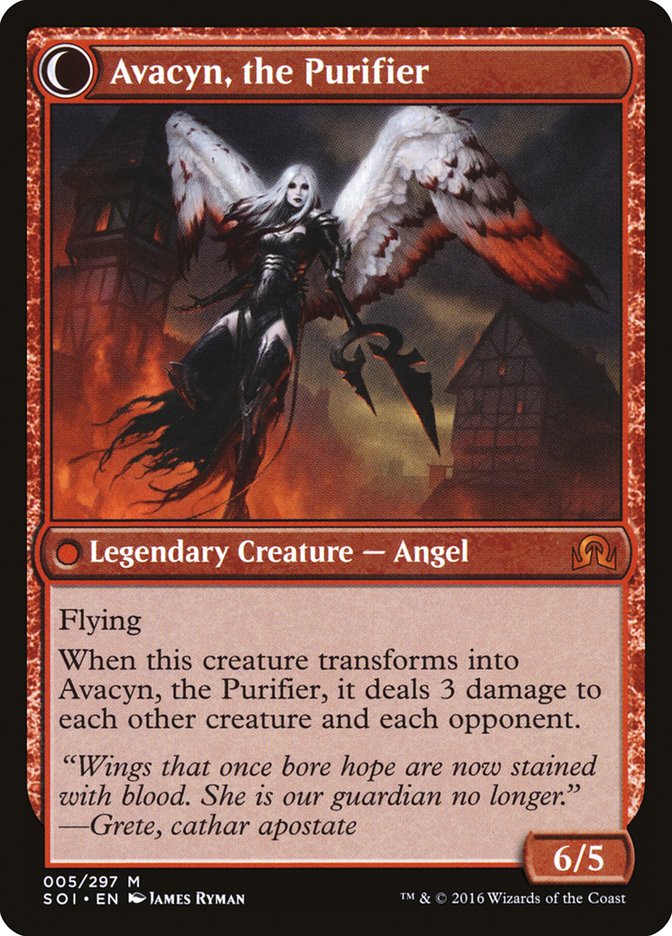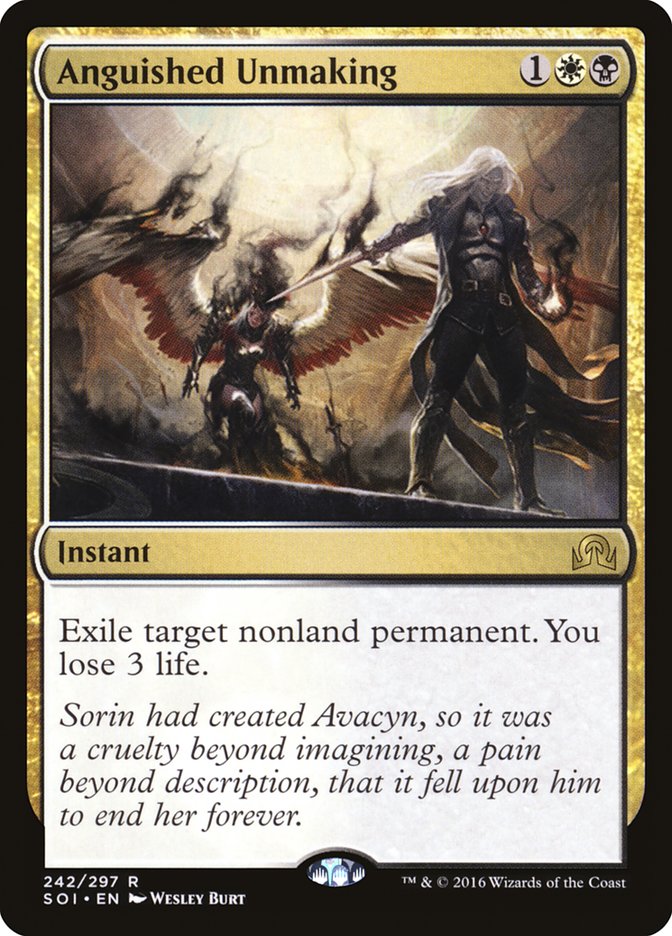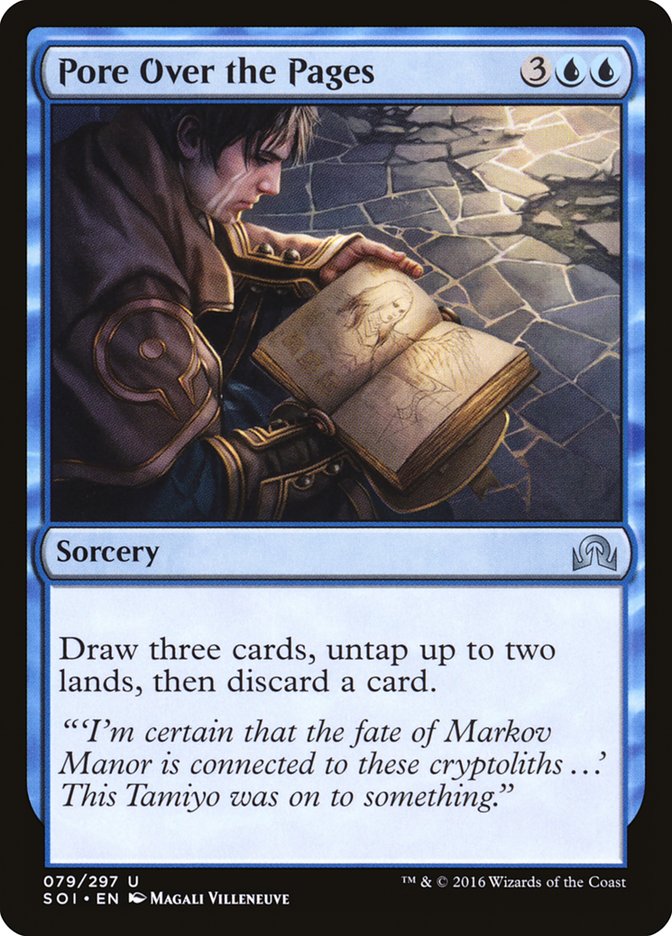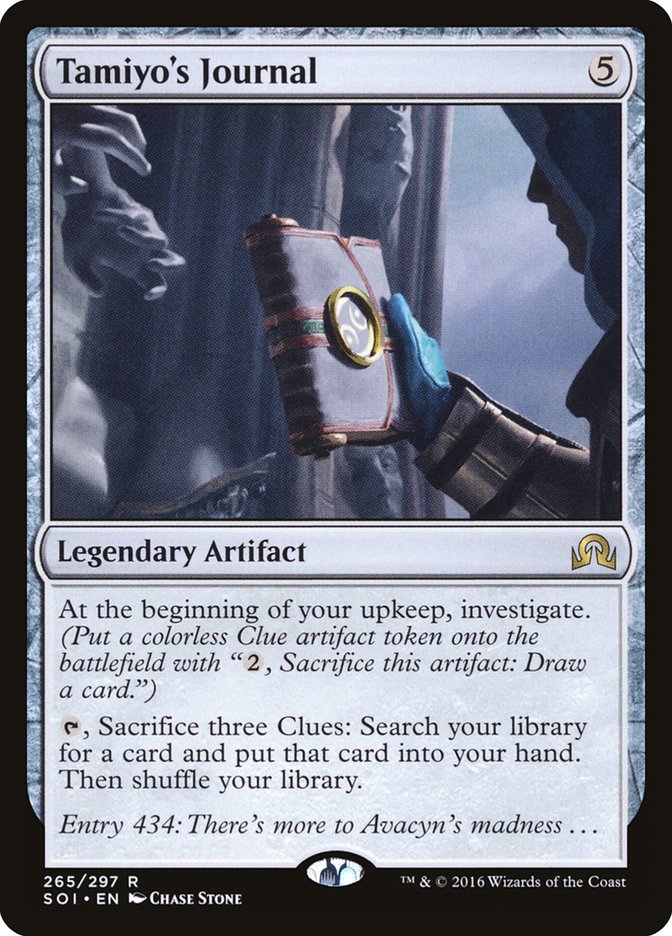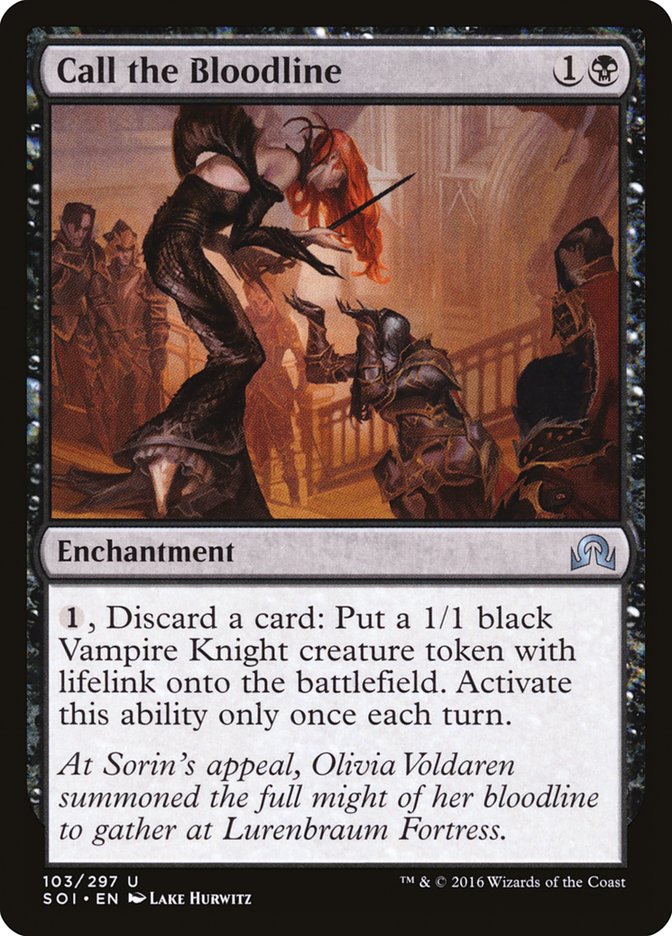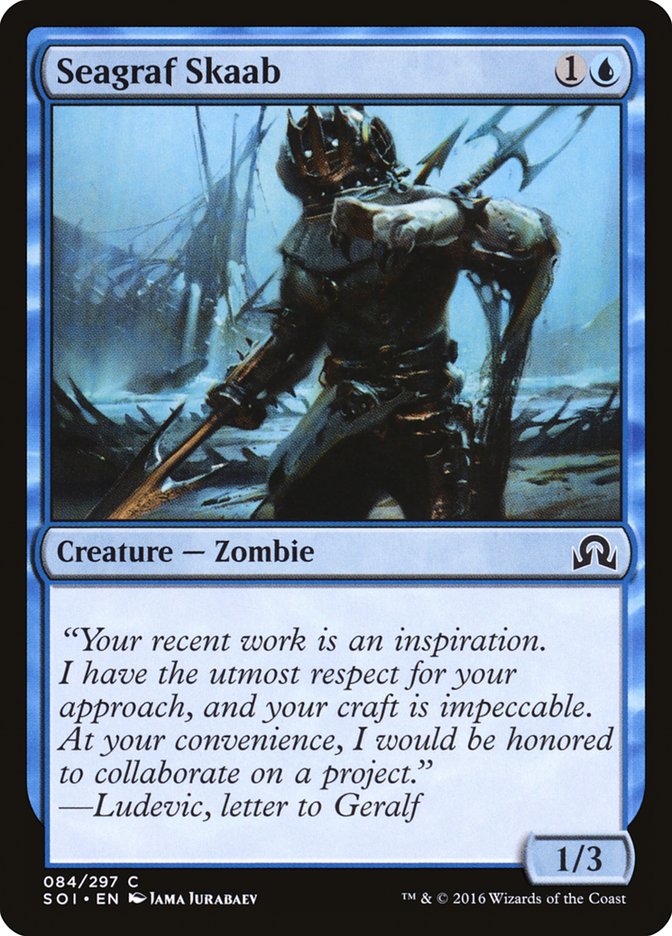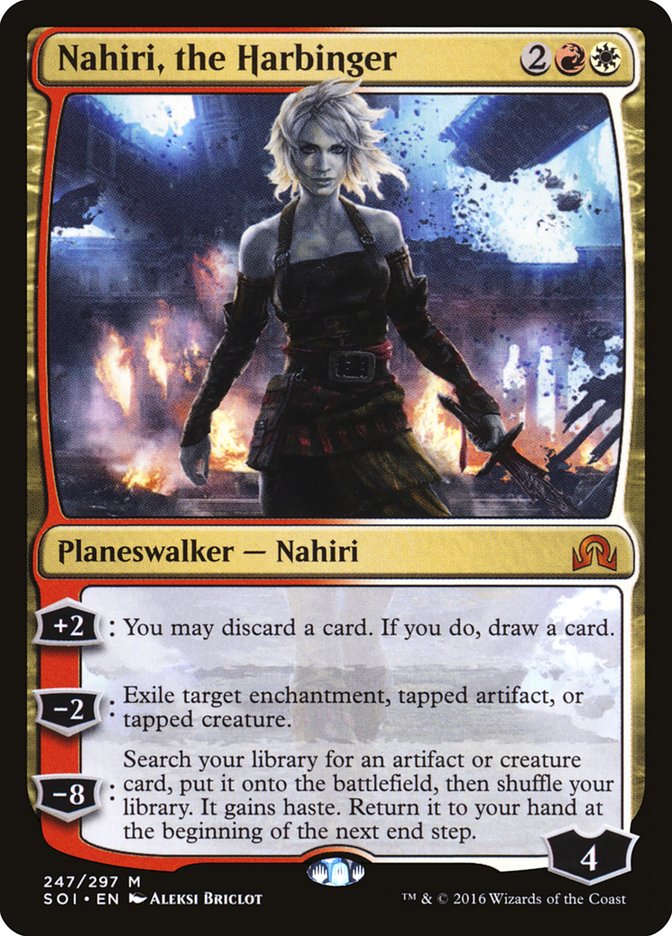 Shadows over Innistrad story series has reached its conclusion with Doug Beyer’s capstone-cliffhanger, “I Am Avacyn.” For a couple of weeks, the Magic Story column will wander the Multiverse before returning to Innistrad and answering the question of what will happen after the Anguished Unmaking of Archangel Avacyn.
Shadows over Innistrad story series has reached its conclusion with Doug Beyer’s capstone-cliffhanger, “I Am Avacyn.” For a couple of weeks, the Magic Story column will wander the Multiverse before returning to Innistrad and answering the question of what will happen after the Anguished Unmaking of Archangel Avacyn.
It’s as good a time as any to look back at the Shadows over Innistrad stories, how they were received, and the intriguing patterns that have emerged.
It all started with “Under the Silver Moon” by Kimberly J. Kreines, a look at the dangers of Innistrad as seen through the eyes of Halana (or “Hal”) and Alena, two monster hunters in love, and the Werewolf planeswalker Arlinn Kord. While not strictly connected to the main storyline involving Jace Beleren and company, I found it a most enjoyable (re-)introduction to the perilous plane. The story is also a showcase of what Ms. Kreines can do; unlike in the stories from Battle for Zendikar block, where she was effectively locked into writing about Nissa Revane, here she had free rein to create characters, introduce them to the world, and give them their own plots.
Next up was “A Gaze Blank and Pitiless” by Ken Troop, a look at Avacyn’s transformation from Archangel to twisted Purifier. Taking place over an unspecified amount of time, it begins with a benevolent act: Avacyn rescues a child after a mother prays to her. But the mother expresses anger to her child as well as love upon the deliverance, and for the first time, the corrupting thoughts appear in Avacyn’s mind. Disturbing encounters and then catastrophes follow. Mr. Troop is consistently one of the best writers of Uncharted Realms, and his storytelling skill lets him take on disasters as diverse as a priest’s crisis of faith and a former Werewolf’s despair at the unraveling of the Cursemute without his tale ever feeling digressive.
The next installment kicks off Jace Beleren’s storyline as he explores the mysteries of Innistrad. “Unwelcome” by Kelly Digges sees Jace visiting his only contact on the plane: Liliana Vess, the ex he ditched on Ravnica at the behest of Gideon Jura to go save Zendikar. It isn’t a particularly happy reunion, but Liliana does let Jace stay the night…in her dungeon. While some moments are overly expository for my taste (the bit about how Jace was manipulated into freeing the Eldrazi, for instance, wanders into “as you know, Liliana” territory), at its best “Unwelcome” has the crackle of a complicated relationship that any Jace-Liliana story should.
After that, Michael Yichao’s “Sacrifice” explores a distant corner of Innistrad, far from the main action. There’s no grand conspiracy this time, just a homegrown cult and a monster all too real. While some commentators didn’t like the story and its Futurama wink at the end, I found it an enjoyable chiller of a tale, well worth the read.
Returning to the Jace story thread, “The Mystery of Markov Manor” by James Wyatt saw Jace enter the manor, note the Nahiri-revised decor, and get out with Tamiyo’s journal. Mr. Wyatt’s story employs an unusual effect, beginning in the third-person with limited access to Jace’s thoughts before entering the first-person, entirely from Jace’s perspective…just as he’s affected by the plane’s madness. It’s not the easiest read in the sequence, and in plot terms, not much happens: go in, get journal, get out. I can’t call the story a complete success, yet I must commend its ambition.
Another Jace story immediately follows. “The Drownyard Temple” by Mel Li follows Jace as he falls deeper into Innistrad’s mystery and madness, eventually becoming so compromised that he makes the massive logical leap that Zombies must mean Liliana Vess’s involvement. The story hits its best notes early, when Tamiyo’s field notes are so pitch-perfect that only someone with the necessary background (like Dr. Li) could have written them. Its weakness is “mad Jace,” whose increasingly fragmented consciousness is hard to follow.
The next story, “Promises Old and New,” leaves Jace for a time and focuses instead on Sorin Markov, Party Crasher. Ari Levitch balances present and long-ago past, revealing part of the epic duel Sorin and Nahiri had almost a millennium ago over his failure to appear when the Eldrazi threatened to escape their prison on Zendikar, a precursor to a vendetta so tremendous that even Sorin Markov feels he must get help from the Vampires who long ago turned their backs on him for his creation of Avacyn. Neither Sorin nor Nahiri comes off looking reasonable from their past feud, though Nahiri has the better argument despite the Flashback being from Sorin’s point of view. The most winning character is Olivia Voldaren, as elegant as she is deadly, powerful enough that she can barter with one of the strongest planeswalkers around. I’m looking forward to her next appearance.
Jace’s wrong conclusion about Liliana’s activities leads to “Liliana’s Indignation,” by Kelly Digges. (It’s worth noting that this is the first repeat author of Magic Story for the cycle, a sign of good balance and work-sharing within Wizards.) It’s an excellent showcase of Liliana’s temptations and struggles, as well as the way she still cares about Jace in her own selfish way. On Innistrad, she’s one of the few people who can get through to Jace, even if he ends up rejecting her advice, and Mr. Digges shows that relationship compellingly, enriching two characters as he advances the overarching plot.
While “Liliana’s Indignation” clearly was meant to move the overall Shadows over Innistrad plot along, “Games” by Alison Luhrs is an enjoyable romp that needs no higher purpose. An epistolary short story, “Games” reproduces the correspondence between the Cecani necromancers Stitcher Geralf and Ghoulcaller Gisa, twins in young adulthood who take sibling rivalry to new heights. Along the way, readers learn that Nahiri recruited Gisa for the construction project seen in “The Drownyard Temple,” not Liliana Vess as Jace Beleren had assumed. But that’s just one bigger-story moment in a fun one-off gem.
James Wyatt’s second story of the Shadows over Innistrad cycle, “The Lunarch Inquisition,” puts yet another piece of the planar puzzle in place. The Church of Avacyn has ditched its Lunarch for a ruling council … stuffed full of demon-worshipping cultists who seem to delight in the inquisition and torture being inflicted on the ordinary Humans of the plane. Thalia, Guardian of Thraben makes her case (a brave stand!) to the corrupt Lunarch Council (bad move!) and only gets saved from execution by the intervention of Odric, Lunarch Marshal, an old friend.
The development of these less-seen characters is compelling in its own right, but particularly interesting is the reappearance of the Geist of Saint Traft, a paragon of bravery and justice who seems to be using Thalia as his mortal instrument. It’s unclear how this small group will figure into the Eldritch Moon storyline. This could have just been a solid one-off effort, but I got the feeling it’s more than that.
Two Jace-involved installments complete the Shadows over Innistrad sequence. The first, “Stories and Endings” by Nik Davidson, is our best look at Tamiyo, the Moon Sage, a planeswalker from among the Moonfolk of Kamigawa. Her magic is linked to the stories on her various scrolls, a neat touch not seen on any other spellcaster in the Multiverse so far (and a perfect literary excuse to showcase miniature stories from Kamigawa and old Mirrodin, plus a poem from an unknown icebound plane, perhaps Dominaria from the Ice Age or Kaldheim).
If Jace lies more on the black side of the blue continuum with his self-centeredness, Tamiyo leans more toward white; she’s willing to put the promise she made never to use the Serra’s Realm scroll above her life and Jace’s. While the contrast between Tamiyo and Jace was enjoyable, as were the mini-stories, the Shadows over Innistrad Game Day playmat spoiled that neither of them would perish by Avacyn’s hand.
And the last glimpse of Avacyn (barring any Flashback or the like, of course) is “I Am Avacyn,” told in the first-person by Doug Beyer. As the cards and playmat foretold, Sorin interrupts Avacyn and becomes quite insistent that she join him in the vault downstairs for some re-education. But Avacyn has her own crisis of faith, seeing Sorin not as a benevolent creator but a threat to all goodness on Innistrad, which leads Sorin to destroy Avacyn.
Cue Avacyn montage, emotional Sorin walk away, Jace screaming “What have you done?” at Sorin’s back, and Tamiyo coming as close as she does to a freakout.
I have mixed feelings about this story. I don’t believe Avacyn was a complex enough character to pull off the first-person approach completely, yet I can’t deny the gut-punch of Avacyn’s “final prayer to the world.” The other installments all led up to this moment, and even though Sorin’s timely arrival is vaguely Vampire ex machina, it’s clear that nothing will be the same for Innistrad.
What isn’t clear is where the story will go next. For that, we’ll have to wait.
Observations
Looking back, I’m pretty happy with these dozen stories. There were no real clunkers, and “Games” in particular would be at home in an anthology of the all-time best Magic fiction.
After reviewing all twelve tales, a few patterns emerged. On the plus side:
Wizards has adapted quickly to the two-act storytelling structure. I’ve written before about two-act structure and how it differs from the three-act structure Magic’s storytelling used for more than a decade. So far, so good with the big end-of-Act-I twists (Kozilek’s Return, the Anguished Unmaking).
The mix of voices is working. Each change of author is a chance to do something new and step away from an installment that didn’t go as planned. In Battle for Zendikar, the overuse of Kimberly J. Kreines and Nissa of the Internal Monologue left no exit route once general opinion turned against The “Ashaya!” Chronicles. This time around, the iffiest part of the story lasted only two installments (the back-to-back “mad Jace” stories in the middle; I don’t count “Liliana’s Indignation, told from her point of view) and was able to move on.
On the other hand…
The “main story” installments have an uphill climb relative to those not spoiled by the cards. When the audience already knows what will happen in a story, the pleasure of surprise vanishes, leaving only enjoyment of language, structure, and so on. Works can and do succeed under those circumstances, obviously; nobody goes to see Hamlet in a theatre wondering if the Danish prince will live to rule the kingdom. But “Games” has an easier time of it than “Liliana’s Indignation,” and Wizards needs to find some way to compensate.
Why did we see so little of Nahiri? Sure, there were glimpses of Sorin’s antagonist, but only a Flashback told from Sorin’s point of view and a hint that she’s recruited Ghoulcaller Gisa for her plans. If Nahiri is behind everything, though, the story evidence (as opposed to the card evidence, like Nahiri’s Machinations) is awfully thin, and we never once heard her speak, either aloud in someone else’s story or through her thoughts in her own tale. The big antagonist is an even bigger cipher, and unless Eldritch Moon fixes that, preferably with a chronicle of Nahiri’s plans in her own words, that hole in the story will prove fatal.
So that’s my take on the Shadows over Innistrad story. What’s yours? What do you hope to see in the Eldritch Moon tales?


